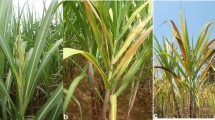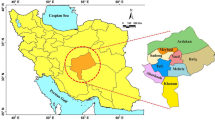Abstract
Sugarcane is a major food and bioenergy crop in India and many fungal pathogens impact cane cultivation across the country. The fungal pathogen Fusarium sacchari causes wilt in sugarcane stalks and severely affects cane production and productivity in the crop. Many commercial varieties were lost due to their severity to the disease. East coast regions, South Gujarat and subtropical plains are identified as the disease endemic regions in the Country. More damages to cane stalks are expected if the disease occurs in association with red rot. Based on morphological and molecular profiles of the isolates F. sacchari was identified as the causal organism. Among the molecular markers, ISSR and IGS-RFLP established variation in F. sacchari efficiently and distinguished this species with other Fusarium spp. Pokkah boeng (PB), another Fusarium disease in sugarcane is characterized by twisting of young leaves and morphological changes in spindle. Under Indian conditions, F. sacchari and F. proliferatum are found associated with PB. Recently, epidemic occurrences of PB are noticed in both the tropical and subtropical regions in the country and its current severity scenario suggests that the disease has become a major disease from minor disease, possibly due to climate changes and this needs detailed investigation. The paper reviews scenario of wilt and PB in the country, impact of the diseases on sugarcane, pathogens and their variability, disease resistance and management.




Similar content being viewed by others
References
Agnihotri VP (1983) Diseases of sugarcane. Oxford and IBH publishing Co, New Delhi, p 363
Agnihotri VP, Rao GP (2002) A century status of sugarcane wilt in India. In: Singh SB, Rao GP, Eswaramoorthy S (eds) Sugarcane crop management. Sci Tech Publishing LLC, Houston, pp 145–160
Agnihotri VP, Singh RP (1989) Sugarcane wilt current status. In: Agnihotri VP, Singh N, Chaube HS, Singh US, Dwivedi TS (eds) Prospective in Plant Pathology. Today and Tomorrow’s printers and publishers, New Delhi, pp 227–237
Bhatti DS, Chohan JS (1970) Antagonism of certain microorganisms to Cephalosporium sacchari. J Res (PAU) 7:631–635
Bolle PC (1927) An investigation into the cause of pokkah boeng and top rot. Archief Suikerindustrie Nederlands-Indie 111(35):589–609
Butler EJ (1906) Fungus diseases of sugarcane in Bengal. Memoirs Depart Agri (India). Bot Ser 1:2–24
Butler EJ, Khan AH (1913) Some new sugarcane diseases. Part I, Wilt, Memoirs Depart Agri (India). Bot Ser 6:180–190
Das IK, Rakshit S, Patil JV (2015) Assessment of artificial inoculation methods for development of sorghum pokkah boeng caused by Fusarium subglutinans. Crop Protect 77:94–101
Dohare S, Mishra MM, Kumar B (2003) Effect of wilt on juice quality of sugarcane. Ann Biol 19:183–186
Gams W (1971) Cephalosporium-artige Schimmelpilze (Hyphomycetes). Gustav Fischer, Stuttgart
Goswami D, Handique PJ, Deka S (2014) Rhamnolipid biosurfactant against Fusarium sacchari-the causal organism of pokkah boeng disease of sugarcane. J Basic Microbiol 54:548–557
Govender P, McFarlane SA, Rutherford RS (2010) Fusarium species causing pokkah boeng and their effect on Eldana saccharina Walker (Lepidoptera: Pyralidae). Proc South Afr Sugar Technol Assoc 83:267–270
Gupta MR, Gupta SC (1976) Assessment of losses caused by wilt disease of sugarcane in western UP. Indian Sugar 26:151–152
Khani KT, Alizadeh A, Nejad RF, Tehrani AS (2013) Pathogenicity of Fusarium proliferatum, a new causal agent of pokkah boeng in sugarcane. Proc Intern Soc Sugar Cane Technol 28:1–5
Kirtikar, Shukla R (1972) Role of seed material in carryover of wilt disease of sugarcane. Indian Sugar 22:89–90
Kulshreshtha JPA, Avasthy PN (1959) An estimate of damage caused to sugarcane crop by the stalk borer Chilo traeaauricilia Dudg. Proc All India Conf Sugarcane Res Deve Workers 3:27–28
Leslie JF (1993) Fungal vegetative compatibility. Ann Rev Phytopathol 31:127–150
Leslie JF, Summerell BA (2006) The Fusarium laboratory manual. Blackwell Publishing Ltd, UK
Leslie JF, Summerell BA, Bullock S, Doe DJ (2005) Description of Gibberella sacchari and neotypification of its anamorph Fusarium sacchari. Mycologia 97:718–724
Martin J, Handojo H, Wismer C (1989) Pokkah boeng. In: Ricaud C, Egan ET, Gillaspie AG, Hughes CG (eds) Diseases of sugarcane: major diseases. Elsevier, Amsterdam, pp 157–168
McFarlane S, Rutherford R (2005) Fusarium species isolated from sugarcane in KwaZulu-Natal and their effect on Eldana saccharina (Lepidoptera: Pyralidae) development in vitro. Proc South Afr Sugar Technol Assoc 79:120–123
Meng JR, Huang HJ, Li YX, Li YJ, Li JQ, Chen BS (2020) First report of Fusarium sacchari causing sugarcane pokkah boeng in China. Plant Dis. https://doi.org/10.1094/PDIS-05-19-0906-PDN
Mohammadi A, Nejad RF, Mofrad NN (2012) Fusarium verticillioides from sugarcane, vegetative compatibility groups and pathogenicity. Plant Protect Sci 48:80–84
Mohanraj D, Alexander KC (1984) A qualitative numerical index for rating severity in sugarcane wilt. Indian Sugar Crops J 10:19–20
Nirenberg H (1976) Mitt. Biol, Bundesanstalt. Land-U. Forstw. Berling-Dahlem, vol 169, p 117
Nordahliawate MSS, Izzati M, Azmi A, Salleh B (2008) Distribution, morphological characterization and pathogenicity of Fusarium sacchari associated with pokkah boeng disease of sugarcane in Peninsular Malaysia. Pertanika J Trop Agric Sci 31:279–286
Oren L, Ezrati S, Cohen D, Sharon A (2003) Early events in the Fusarium verticillioides-maize interaction characterized by using a green fluorescent protein expressing transgenic isolate. Appl Environ Microbiol 69:1695–1701
Patil AS, Singh H, Sharma SR, Rao GP (2007) Morphology and pathogenicity of isolates of Fusarium moniliformae causing Pokkah boeng of sugarcane in Maharashtra. In: Ram RC, Singh A (eds) Microbial diversity: modern trends. Daya Publishers, New Delhi, pp 234–263
Petrovic T, Burgess LW, Cowie I, Warren RA, Harvey PR (2013) Diversity and fertility of Fusarium sacchari from wild rice (Oryza australiensis) in Northern Australia, and pathogenicity tests with wild rice, rice, sorghum and maize. Euro J Plant Pathol 136:773–788
Poongothai M, Viswanathan R, Malathi P, Ramesh Sundar A (2014a) Sugarcane wilt: pathogen recovery from different tissues and variation in cultural characters. Sugar Tech 16:50–66
Poongothai M, Viswanathan R, Ramesh MP, Sundar A (2014b) Fusarium sacchari causing sugarcane wilt: variation in morphological characteristics of the pathogen. Intern Sugar J 116:54–63
Poongothai M, Viswanathan R, Malathi P, Ramesh-Sundar A, Prasanth NC, Balaji CG (2015) Genetic relatedness among Fusarium populations associated with sugarcane wilt in India: bridging molecular variability and phylogenetic diversity. J Sugarcane Res 5(1):33–48
Rao GP, Agnihotri VP (2000) Wilt. In: Rott P, Bailey R, Comstock JC, Croft B, Saumtally S (eds) A guide to sugarcane diseases. CIRAD/ISSCT, Montpellier, pp 193–197
Rosas-Guevara V, Hernández-Arenas M, Miranda-Marini R, Bravo-Mosqueda E, Berriozabal-Onofre A (2014) Identification and morphological variability of pokkah boeng (Fusarium spp.) on sugar cane, in Mexico. Invest Agropecuaria 11(2):119–126
Sardhana HR, Singh N, Tripathi BK (2000) Investigation on the relationship between root borer and wilt disease of sugarcane. Indian J Entomol 62:11–17
Sarma MN (1976) Wilt disease of sugarcane. Sugarcane Pathol Newsl 15(16):30–33
Scindiya M (2013) Molecular characterization of Fusarium species associated with wilt and pokkah boeng/top rot diseases of sugarcane. M. Phil thesis, Bharathiar University, Coimbatore
Sharma DDK, Bharti YP, Singh PK, Shukla DN, Kumar A (2014) Studies on prevalence and identification of new races of Fusarium moniliforme Sheldon incitant of pokkah boeng disease from Uttar Pradesh. Global J Biol Agric Health Sci 3(2):53–61
Sheldon JL (1904) A corn mold (Fusarium moniliforme). New Agr Exp Sta Ann Rep 17:23–32
Singh OP (1973) Wilt assumes a serious problem in the sugarcane riverine belt of Saraswati Sugar Mills Area, Yamunanagar, Ambala. Indian Sugar 23:129–130
Singh K, Singh RP (1974) Involvement and pathogenicity of Acremonium in wilt syndrome of sugarcane. Sugarcane Pathol Newsl 11(12):24–25
Singh O, Waraitch KS (1981) Effect of wilt and red rot induced stress on quality deterioration of sugarcane. Sugarcane Pathol Newsl 27:25–30
Singh K, Singh N, Singh RP, Mishra SR (1980) Development of wilt disease in sugarcane through sett and soil inoculations. Sugarcane Pathol Newsl 24:23–25
Singh A, Chauhan SS, Singh A, Singh SB (2006) Deterioration in sugarcane due to pokkah boeng disease. Sugar Tech 8:187–190
Subba Raja KT, Natarajan S (1972) Sugarcane wilt caused by Cephalosporium sacchari and Fusarium moniliforme in India. Sugarcane Pathol Newsl 8:21–23
Vishwakarma SK, Kumar P, Nigam A, Singh A, Kumar A (2013) Pokkah Boeng: An emerging disease of sugarcane. J Plant Pathol Microbiol 4(3):1000170
Viswanathan R (2010) Plant Disease: Red rot of Sugarcane. Anmol Publishers, New Delhi
Viswanathan R (2012a) Sugarcane diseases and their management, sugarcane breeding institute, Coimbatore, India
Viswanathan R. (2012b) Need for a paradigm shift in sugarcane disease management In: Nair NV, Puthira Pratap D, Viswanathan R, Srikanth J, Bhaskaran A, Ram B (edss) Perspectives in sugarcane agriculture, society for sugarcane research and development, Coimbatore, India, pp 171–206
Viswanathan R (2013a) Status of sugarcane wilt: one hundred years after its occurrence in India. J Sugarcane Res 3(2):86–106
Viswanathan R (2013b) Sustainable ecofriendly disease management systems in sugarcane production under the changing climate – A review. J Mycol Plant Pathol 43:12–27
Viswanathan R (2018) Changing scenario of sugarcane diseases in India since introduction of hybrid cane varieties: path travelled for a century. J Sugarcane Res 8(1):177–211
Viswanathan R, Padmanaban P (2008) Hand book on sugarcane diseases and their management. Sugarcane Breeding Institute, Coimbatore
Viswanathan R, Rao GP (2011) Disease scenario and management of major sugarcane diseases in India. Sugar Tech 13:336–353
Viswanathan R, Malathi P, Ramesh Sundar A, Poongothai M, Singh N (2006) Current status of sugarcane wilt in India. Sugar Cane Intern 24(4):1–7
Viswanathan R, Poongothai M, Malathi P (2011) Pathogenic and molecular confirmation of Fusarium sacchari causing wilt in sugarcane. Sugar Tech 13:68–76
Viswanathan R, Poongothai M, Malathi P, Ramesh Sundar A (2012) Sugarcane wilt: New insights into the pathogen identity, variability and pathogenicity. In: Viswanathan R, Sundar AR (eds) Functional plant science and biotechnology 6, special issue 2. Global Science Books, Ikenobe, Japan, pp 30–39
Viswanathan R, Malathi P, Annadurai A, Naveen Prasanth C, Scindiya M (2014) Sudden occurrence of wilt and pokkah boeng in sugarcane and status of resistance in the parental clones in national hybridization garden to these diseases. J Sugarcane Res 4(1):62–81
Viswanathan R, Poongothai M, Malathi P, Prasanth CN (2015) Sugarcane wilt: simulation of pathogenicity through different methods and environments. Intern Sugar J 117:286–293
Viswanathan R, Balaji CG, Selvakumar R, Malathi P, Ramesh Sundar A, Prasanth CN, Chhabra ML, Parameswari B (2017) Epidemiology of Fusarium diseases in sugarcane: a new discovery of same Fusarium sacchari causing two distinct diseases, wilt and pokkah boeng. Sugar Tech 19:638–646
Viswanathan R, Balaji CG, Selvakumar R, Malathi P, Ramesh Sundar A, Annadurai A, Pazhany AS, Manivannan K, Nithyanantham R (2019) Identification of sources of resistance to wilt caused by Fusarium sacchari in Indian sugarcane parental population. Intern Sugar J 121:838–846
Walker JH, Went FAFC (1896) Overview of the diseases of sugarcane in Java. Arch. Suikerind. Ned. Indie IV, pp 427–435
Wang JH, Peng XD, Lin SH, Wu AB (2015) First report of Fusarium head blight of wheat caused by Fusarium sacchari in China. Plant Dis 99:160
Waraitch KS (1981) Wilt disease in Co 1148 in Punjab and assessment of losses caused by it. Indian Sugar 31:37–40
Acknowledgements
The author is grateful to Directors of ICAR-SBI, Coimbatore and Dr. M. Anandaraj, former Director, ICAR-IISR, Calicut and National Coordinator, ICAR-PhytoFuRa for the encouragement.
Author information
Authors and Affiliations
Corresponding author
Additional information
Publisher's Note
Springer Nature remains neutral with regard to jurisdictional claims in published maps and institutional affiliations.
Rights and permissions
About this article
Cite this article
Viswanathan, R. Fusarium diseases affecting sugarcane production in India. Indian Phytopathology 73, 415–424 (2020). https://doi.org/10.1007/s42360-020-00241-y
Received:
Revised:
Accepted:
Published:
Issue Date:
DOI: https://doi.org/10.1007/s42360-020-00241-y




